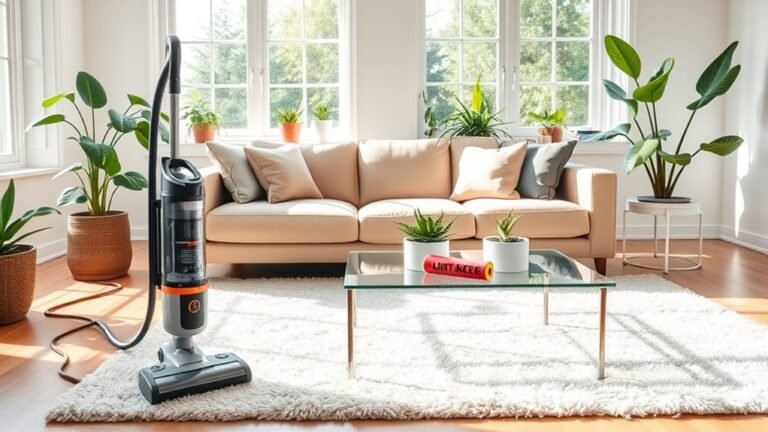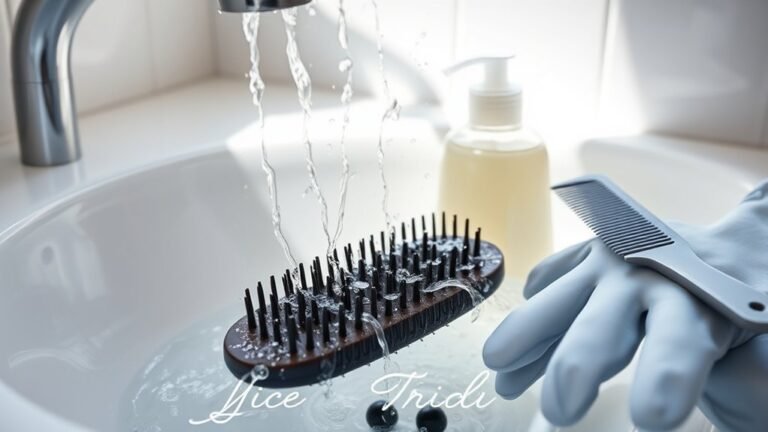Seasonal Maintenance Tips for Pet Mess
To manage pet messes year-round, start with spring decluttering and regular washing of beds to cut allergens. In summer, brush pets daily and use natural odor eliminators. Prepare for fall by organizing a mudroom and protecting floors from dirt. For winter, maintain indoor potty areas and promptly clean accidents with enzymatic cleaners. Use stain-resistant furniture and invest in quality cleaning tools. Consistent grooming and cleaning routines keep your home fresh and comfortable. Discover more tips tailored for every season to ease your routine.
Spring Cleaning Strategies for Pet Owners
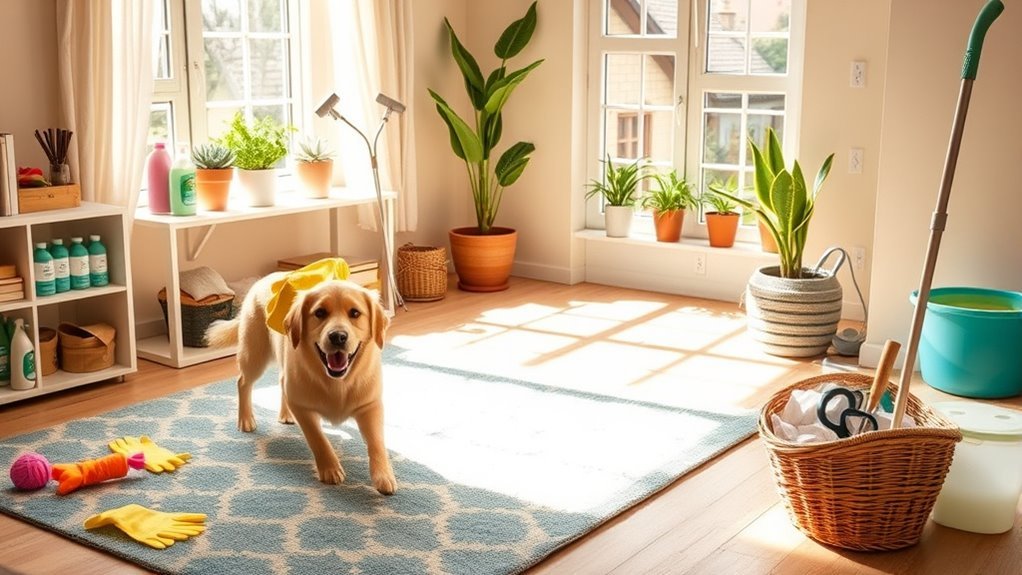
Although spring cleaning can feel overwhelming, it’s an essential task for pet owners to guarantee a safe and healthy environment for their furry friends. Start with spring decluttering—remove unused toys, bedding, and supplies that may harbor dirt or allergens. This clears space and reduces stress for both you and your pet. Next, focus on pet friendly organization by designating specific storage for food, grooming tools, and toys, keeping everything accessible yet tidy. Choose non-toxic cleaning products to avoid harmful residues, and wash pet beds and blankets regularly to prevent bacteria buildup. By embracing these strategies, you create a streamlined, safe home that supports your pet’s well-being and your desire for a clutter-free, liberated lifestyle. Using natural cleaning agents like vinegar and baking soda ensures safety for both pets and family during cleaning.
Managing Summer Shedding and Odors
Once your home is refreshed and organized for spring, summer brings its own set of challenges for pet owners, particularly when it comes to shedding and odors. To keep your space fresh and free, consider these effective shedding solutions and odor eliminators:
- Regular Grooming: Brush your pet daily to catch loose fur before it spreads, reducing shedding and keeping your pet comfortable.
- High-Quality Diet: A balanced diet supports healthy skin and coat, minimizing excessive shedding and unpleasant smells.
- Odor Control Products: Use enzymatic cleaners and natural odor eliminators on floors and furniture to neutralize pet smells without harsh chemicals.
- Using air purifiers can help filter out pet dander and odors, significantly improving indoor air quality.
Preparing Your Home for Fall Mud and Leaves
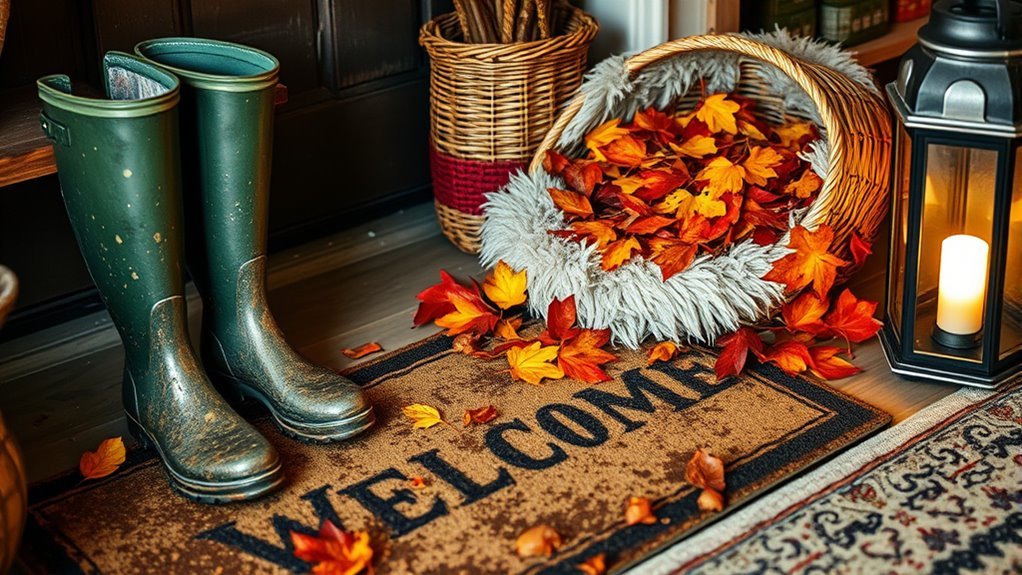
As fall arrives, you’ll want to create a mudroom area with easy-to-clean mats and storage for pet gear to keep your home tidy. Regular leaf cleanup is essential to prevent slippery surfaces and reduce allergens that can affect your pet’s health. With these simple setups, you can manage the seasonal mess while keeping your pets comfortable and safe. Additionally, using washable covers on furniture can help protect your home from mud and dirt tracked inside during this season.
Mudroom Setup Essentials
A few key items can make all the difference when setting up your mudroom for the fall season. With mud and leaves tracking in, you need a space that’s both functional and welcoming. Effective mudroom organization helps you contain messes without sacrificing style, especially when you choose pet friendly decor that accommodates your furry friends.
- Durable mats and rugs — Choose waterproof, easy-to-clean options to catch mud and leaves immediately.
- Storage solutions — Hooks, cubbies, and bins keep leashes, boots, and pet gear tidy and accessible.
- Cleaning station — A small sink or portable wash basin lets you rinse paws quickly, preventing messes from spreading.
These essentials give you freedom from constant cleaning, making your fall changes smoother and more enjoyable.
Leaf Cleanup Strategies
Three key strategies can make leaf cleanup less overwhelming and help keep your home’s entryways clear of fall mud and debris. First, choose effective leaf disposal methods like composting or mulching to reduce waste and nourish your yard. Second, schedule regular yard debris management to prevent buildup that attracts pests. Third, use tools such as rakes and leaf blowers efficiently to save time and energy.
| Strategy | Benefit |
|---|---|
| Composting Leaves | Enriches soil naturally |
| Mulching with Leaves | Protects plants and retains moisture |
| Scheduled Cleanup | Prevents mud accumulation |
| Proper Tool Use | Speeds up cleanup |
Winter Tips for Handling Pet Accidents Indoors
While colder weather keeps you and your pet indoors more often, it can also increase the chances of indoor accidents. Managing these moments with patience and the right strategies helps maintain your freedom and comfort at home. Here are three essential tips for winter pet potty and indoor training success:
- Create a designated pet potty area indoors: Use absorbent mats or artificial grass to encourage your pet to relieve themselves in a consistent spot.
- Maintain a strict schedule: Regular feeding and potty breaks reduce unexpected accidents by reinforcing routine.
- Clean accidents promptly with enzymatic cleaners: This prevents lingering odors that might confuse your pet and cause repeated accidents.
Additionally, keeping cleaning products that are pet-safe and effective on hand ensures a healthy home environment while dealing with messes.
Protecting Floors and Furniture Year-Round
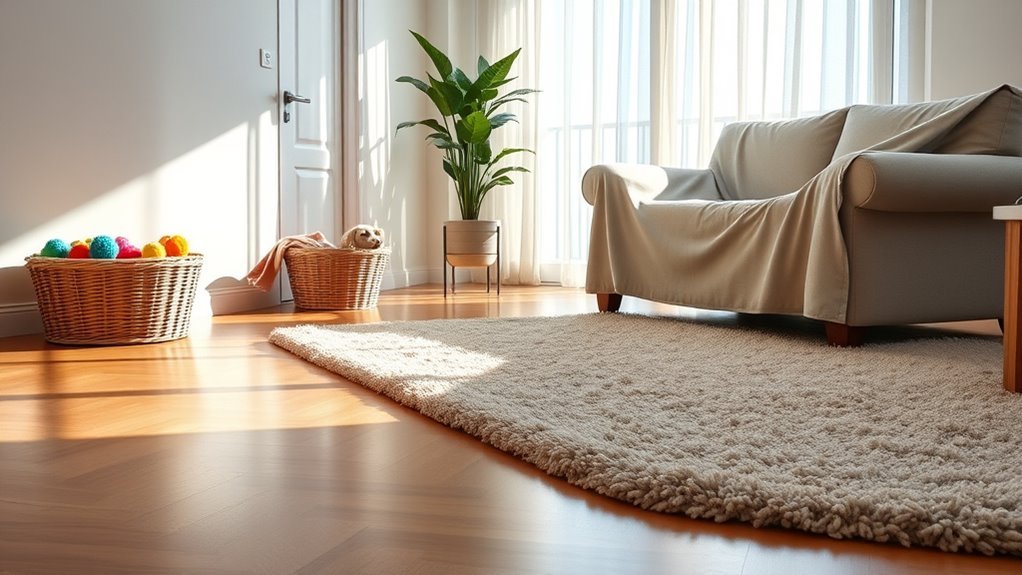
To keep your floors and furniture looking their best all year, focus on durable floor protection like mats or rugs in high-traffic areas. Choosing stain-resistant fabrics can save you time and stress when accidents happen. Don’t forget regular deep cleaning to maintain both appearance and hygiene in your pet-friendly home. Regular grooming also helps reduce shedding and maintain a cleaner environment, benefiting your home’s cleanliness.
Durable Floor Protection
Protecting your floors and furniture from pet-related wear and tear requires durable solutions that can withstand daily activity. You want to keep your living space carefree and damage-free without restricting your pet’s freedom. Here are three effective strategies:
- Use high-quality floor mats in high-traffic and feeding areas to catch dirt, spills, and scratches.
- Apply protective coatings to hardwood or laminate floors to create a resilient barrier against moisture and paw marks.
- Place furniture protectors or slipcovers on items prone to scratching or chewing, offering both defense and easy cleaning.
Stain-Resistant Fabric Choices
Even if you take every precaution with your pet, accidents happen—and that’s where stain-resistant fabrics can make a real difference. Choosing pet friendly materials like microfiber, leather, or tightly woven synthetic fabrics gives you that freedom to relax without constant worry. These easy clean options resist stains and repel liquids, so spills and messes don’t soak in or leave lasting damage. When picking upholstery or rugs, prioritize those treated with stain-resistant finishes—they simplify cleanup and extend your furniture’s life. You don’t have to sacrifice style for practicality; many modern fabrics combine durability with attractive designs. By investing in the right materials, you create a home that welcomes your pet and supports easy maintenance year-round, keeping your floors and furniture protected without limiting your lifestyle.
Regular Deep Cleaning
While stain-resistant fabrics make daily life easier, regular deep cleaning is essential to truly maintain your floors and furniture throughout the year. Tackling pet hair buildup and ensuring proper odor control will keep your home feeling fresh and inviting. Here’s how you can stay ahead:
- Schedule professional carpet and upholstery cleaning at least twice a year to remove embedded pet hair and dander that regular vacuuming misses.
- Use enzymatic cleaners specifically designed for pet odors to break down smells at the source, preventing lingering discomfort.
- Rotate and deep-clean pet bedding and cushions frequently, reducing allergens and maintaining a hygienic environment.
Essential Tools and Products for Pet Mess Maintenance
Keeping your home clean despite pet messes requires the right tools and products tailored for effective maintenance. You’ll want to invest in quality pet cleaning supplies like enzymatic cleaners that break down organic stains and odors at their source. Odor eliminators are essential—not just masking smells but neutralizing them—to keep your space fresh and welcoming. A handheld vacuum or pet-specific vacuum attachments can swiftly remove hair and debris from floors and furniture, saving you time. Don’t overlook durable microfiber cloths and disposable wipes for quick spot cleaning. Having a sturdy litter mat or washable pet pads also helps contain messes. With these essentials on hand, you can maintain your home’s cleanliness easily, giving you more freedom to enjoy time with your pets without constant worry about messes. Establishing a regular cleaning routine for pet areas is key to managing messes effectively and maintaining a fresh home environment.
Health and Hygiene Practices to Reduce Mess
Because your pet’s health directly affects the cleanliness of your home, adopting consistent health and hygiene practices is essential to reducing mess. By prioritizing pet hygiene, you not only protect your furry friend but also create a fresher, more inviting space free from persistent odors. Here’s how you can make a difference:
- Regular Grooming: Brush and bathe your pet routinely to minimize shedding and prevent dirt buildup, vital for effective odor control.
- Clean Living Areas: Wash bedding and toys frequently to eliminate bacteria and smells that contribute to mess.
- Balanced Diet and Hydration: Feed high-quality food and provide plenty of water to support digestion and reduce accidents.
Ensuring the use of hypoallergenic products when cleaning helps protect your pet’s sensitive skin and respiratory health.
Embracing these steps gives you freedom from constant cleaning, letting you enjoy your pet’s company without the stress of mess.
Frequently Asked Questions
How Can Diet Changes Reduce Seasonal Pet Messes?
You can reduce messes by making thoughtful diet adjustments for your pet. Changing their food to higher-quality, easily digestible options minimizes loose stools and shedding. Including supplements like omega-3 fatty acids supports skin health, which cuts down on dander and fur around your home. These diet adjustments not only promote your pet’s well-being but also lead to noticeable mess reduction, giving you more freedom to enjoy a cleaner, hassle-free environment.
What Are the Best Outdoor Pet Toys to Minimize Mess?
Did you know 68% of dog owners report less mess when using outdoor toys? To minimize mess, choose interactive fetch toys that keep your pet engaged and physically active, reducing destructive behavior. Durable chew toys are also great—they withstand rough play and prevent shredded debris around your yard. By selecting these types, you give your pet freedom to play while keeping your space cleaner and more enjoyable for everyone.
How Often Should Pet Bedding Be Washed Each Season?
You should adjust your pet bedding washing frequency based on bedding materials and season. Synthetic fabrics might need washing every two weeks, while natural fibers like cotton could last three weeks before requiring a clean. If your pet sheds heavily or has allergies, washing weekly helps maintain freshness and reduces mess. Keeping bedding clean guarantees your pet’s comfort and your home’s freedom from odors and dirt, making maintenance easier throughout the year.
Can Certain Pet Breeds Cause More Seasonal Messes?
Yes, certain pet breeds can cause more seasonal messes due to their breed characteristics and grooming needs. If your pet has a thick or double coat, they’re likely to shed heavily during seasonal changes, which means more fur around your home. Breeds with high grooming requirements might also track in dirt or require more frequent baths. Understanding your pet’s breed traits helps you manage messes while keeping them comfortable and happy.
Are There Natural Remedies for Seasonal Pet Anxiety Messes?
You can definitely try natural remedies for seasonal pet anxiety messes. Herbal calming supplements, like chamomile or valerian root, often help soothe your pet without harsh chemicals. Essential oils, such as lavender or frankincense, can also create a relaxing environment when diffused safely. Just make sure you research proper usage and concentrations to keep your furry friend safe. These options give you a gentle way to ease anxiety and enjoy more freedom together.

